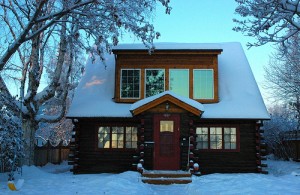Is Your House Ready For Winter?
Pre-Winter Checklist


Windows & Doors
The first place to start with your winter maintenance is checking that all your windows and doors close and seal properly. Installing new weatherstripping and adjusting the fit of windows and doors can save you hundreds of dollars in heating and cooling costs. If you have old windows you might want to consider installing replacement windows.
Furnaces and Fire Places
You should have your furnace serviced yearly (if it’s an oil burner) or according to the manufacturers recommended service plan. Most furnaces require some maintenance to operate efficiently and safely. It’s also a good idea to change filters. If you own a furnace that’s 20 years old or older it might make sense to have it replaced. There are numerous government and utility company rebates available for the installation of energy efficient furnaces and water heaters.
It’s also extremely important to keep vents clear during snow storms. Many of today’s newer boilers have vents and fresh air intakes located outside near the ground vs in a chimney. These vents can get buried in the snow and cause a severe carbon-monixide risk. Be sure to keep them shoveled out or even build a small temporary roof over them.
Insulation
One of the biggest losses of heat and therefore energy is through the roof of houses. If your attic doesn’t have sufficient insulation then installing an additional layer of insulation can save you big money. Installing additional insulation is really easy to do and a great DIY project. The U.S. Department of Energy has a great site with information on the recommended level of insulation.
Roofs
Fall is a great time to check your roof before the harsh Winter sets in. Roofs should be checked for missing, loose or damaged shingles or roofing material. Be sure to check valley flashing, counter flashing and ridge vents to ensure they are properly attached and not damaged. If you have a steep roof you may want to hire a professional roofer to inspect the roof for you.
Protect Landscaping
Before the first snow flies you should take steps to protect fragile shrubs and trees. Wrapping shrubs with burlap bags or installing wood shelters over them can protect the plants from the heavy weight of wet snow and snow banks. Covering material can also protect plants and trees from damage due to extreme cold temperatures.
Photo Credit: Wonderlane
Recent Posts
Framing Stick Nailer vs Coil Nailer
Which is Better a Stick Nailer or Coil Nailer? Framers have many choices in nailers…
How Many Roofing Nails Per Square of Shingles
Estimating How Many Nails for a New Roof When it comes to estimating materials for…
Composite / PVC Decking – Layout Tips & Advice
Composite / PVC Decking Layout Tips and Advice Composite and PVC decking have really changed…
Benefits of an ERV System (Energy Recovery Ventilator)
Benefits of ERV Systems (Energy Recovery Ventilator) If you're building a new home or doing…
Vermiculite Attic Insulation Abatement
Vermiculite Attic Insulation If your home was built before 1990 there is a chance it…
Nuisance Tripping of AFCI (Arc Fault) Circuit Breakers
Arc Fault (AFCI) Circuit Breakers Tripping Often An arc-fault circuit interrupter (AFCI) or arc-fault detection…
View Comments
I have a room on the second floor of my house that has two sides exposed to the cold/hot attic area. The wall construction from the inside out is as follows: 1/2" drywall, 2x6 wood studded wall with R-19 faced fiberglass insulation. Then on the cold side(attic side of the wall is 1/2" OSB wood panels. To gain more "R" value efficiency in the wall what would be better to install on the cold/hot side of the wall over the OSB board?
NOTE: I have approx R-60 blown fiberglass on the ceiling areas.
Questions:
1. EPS foam board or foil wrap material?
2. If foam board, what thickness?
3. If foil wrap, what type? bubble foil wrap or no bubble?
4. Will either product create a vapor barrier problem for the wood wall?
5. Would you suggest any other product to increase the "R" value of the wall?
Tim - Interesting situation but it's actually very similar to existing homes where people decide to add another layer of insulation on the outside prior to re-siding the home. I think I'd choose a foam product. In fact I'd probably be inclined to use a foil faced polyiso board. Thickness depends on budget and how much insulation value you want. I'd use a minimum of 1 inch.
The vapor barrier question is a good one and one that has no perfect answer. This is such a unique situation but the reality is that wall is not exposed to rain and wind so the moisture issue is of lesser concern.
Hope this helps.